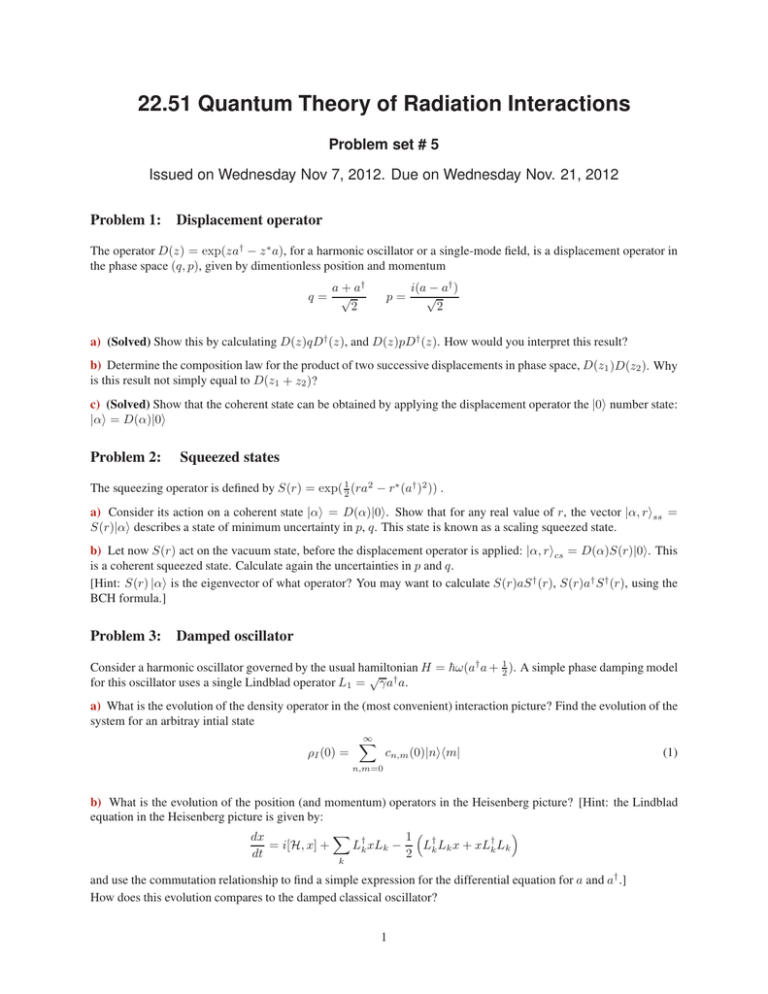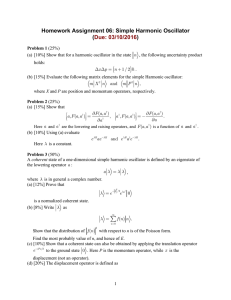22.51 Problem Issued on Wednesday Nov 7, 2012. Due on Wednesday... Problem 1: Displacement operator
advertisement

22.51 Quantum Theory of Radiation Interactions Problem set # 5 Issued on Wednesday Nov 7, 2012. Due on Wednesday Nov. 21, 2012 Problem 1: Displacement operator The operator D(z) = exp(za† − z ∗ a), for a harmonic oscillator or a single-mode field, is a displacement operator in the phase space (q, p), given by dimentionless position and momentum q= a + a† √ 2 p= i(a − a† ) √ 2 a) (Solved) Show this by calculating D(z)qD† (z), and D(z)pD † (z). How would you interpret this result? b) Determine the composition law for the product of two successive displacements in phase space, D(z1 )D(z2 ). Why is this result not simply equal to D(z1 + z2 )? c) (Solved) Show that the coherent state can be obtained by applying the displacement operator the |0) number state: |α) = D(α)|0) Problem 2: Squeezed states The squeezing operator is defined by S(r) = exp( 12 (ra2 − r∗ (a† )2 )) . a) Consider its action on a coherent state |α) = D(α)|0). Show that for any real value of r, the vector |α, r)ss = S(r)|α) describes a state of minimum uncertainty in p, q. This state is known as a scaling squeezed state. b) Let now S(r) act on the vacuum state, before the displacement operator is applied: |α, r)cs = D(α)S(r)|0). This is a coherent squeezed state. Calculate again the uncertainties in p and q. [Hint: S(r) |α) is the eigenvector of what operator? You may want to calculate S(r)aS † (r), S(r)a† S † (r), using the BCH formula.] Problem 3: Damped oscillator Consider a harmonic oscillator governed by the usual hamiltonian H = lω(a† a + 12 ). A simple phase damping model √ for this oscillator uses a single Lindblad operator L1 = γa† a. a) What is the evolution of the density operator in the (most convenient) interaction picture? Find the evolution of the system for an arbitray intial state ρI (0) = ∞ L cn,m (0)|n)(m| (1) n,m=0 b) What is the evolution of the position (and momentum) operators in the Heisenberg picture? [Hint: the Lindblad equation in the Heisenberg picture is given by: ) L † dx 1( † Lk Lk x + xL†k Lk = i[H, x] + Lk xLk − dt 2 k and use the commutation relationship to find a simple expression for the differential equation for a and a† .] How does this evolution compares to the damped classical oscillator? 1 Problem 4: Thermal radiation Consider the thermal radiation, that is, the e.m. field at thermal equilibrium at the temperature T (consider just one mode and polarization of the e.m.). a) Write a formal expression for the state of the field. Using the number state basis, calculate the partition function. [Hint: use the geometrical series] b) What is the average number of photons (n) in the thermal e.m. field? Rewrite the expression for the density operator of the thermal field in terms of (n). c) Plot the probability distribution function of the photon number in the thermal radiation and compare it to the distribution of a coherent state and of a number state with the same photon number average. Problem 5: Boson operators Consider the creation and annihilation operators for the e.m. field a†n , an . They are example of boson operators, obeying the commutation relationships: [am , a†n ] = δm,n 11, [am , an ] = [a†m , a†n ] = 0, ∀n, m = 1, . . . N Let’s fix N = 2 and consider the operators J+ = a1† a2 , J− = a†2 a1 , J3 = (a†1 a1 − a†2 a2 )/2 a) Find the commutators [J+ , J− ], [J3 , J+ ] and [J3 , J− ] b) Do you see similarities with the operators σ ± and σz ? What would be the operators equivalent to σx and σy ? Problem 6: Eigenstate of the creation operator? We know that the coherent state is the eigenstate of the annihilation operator. Ever wondered why nobody talks about the eigenstate of the creation operator? It does not exist! a) Show that the eigenstate of the creation operator does not exist. [Hint: try to find the eigenvalue and an expression of the eigenstate in terms of an expansion of number operators, by using the commutation relationship with the number operator] 2 MIT OpenCourseWare http://ocw.mit.edu 22.51 Quantum Theory of Radiation Interactions Fall 2012 For information about citing these materials or our Terms of Use, visit: http://ocw.mit.edu/terms.




